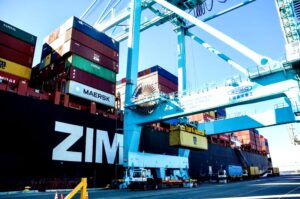Israeli carrier Zim posted a net profit of $1.34bn for the second quarter, for an interim H1 result of $3bn, and believes it can navigate any downturn in the liner markets.

The carrier reaffirmed its full-year guidance of an adjusted ebit of $6.3bn, to $6.7bn.
“We feel confident in our ability to develop quarter after quarter of profit,” Zim CFO Xavier Destriau told investors at yesterday’s Q2 earnings call.
Revenue for the period was $3.4bn, from a 7% year-on-year decrease in liftings, to 856,000 teu, and an industry-leading average rate of $3,596 per teu.
Zim president and CEO Eli Glickman said he was “very proud” of the carrier’s results and, despite a gradual decline, both spot and contract rates “remain highly profitable”.
Zim’s spot and contract business is roughly 50:50 across its tradelanes, with both markets in general “paying the same”, according to Mr Destriau.
However, he admitted that the premium surcharges on the transpacific had “faded” in the past quarter, although “our vessels have been sailing full”.
Mr Glickman said: “We are confident our differentiated strategy, the proactive steps we have taken to strengthen our commercial offering and secure cost efficient newbuild capacity and continued investment in digital initiatives and disruptive technologies will position Zim as a top performer in our industry.”
According to Alphaliner data, Zim is currently the tenth-biggest carrier in terms of capacity, with an operating fleet of 138 ships of 514,560 teu, of which only eight are owned by the carrier.
Read Also: Container Fleet Growth Up 11.6% From June 2019, Catching Up With Transport Demand
Moreover, it has an impressive orderbook of 44 vessels, with a capacity of 389,904 teu, which the carrier will take via long-term charters. They include ten 15,000 teu LNG-powered vessels, stemmed for delivery between February next year and February 2024 and will be deployed on Zim’s Asia-US east coast trade.
Zim regards its strategy of chartering new ships rather than buying “old assets” as being more flexible than its competitors, pointing to the 28 chartered vessels that could be returned to owners next year in the case of a downturn, and another 34 that could, if necessary, be off-hired in 2024.
Speaking to The Loadstar yesterday, Mr Glickman and Mr Destriau argued that the so-called ‘normalisation’ of the liner industry, when it eventually arrived, would be very different to the cut-throat, market-share-grab mentality that existed before the pandemic.
“The ability of the industry to maintain margins that will allow the industry to deliver results that will exceed the cost of capital will be preserved, which is something our industry has not managed to deliver in past cycles,” said Mr Destriau.
Kindly like us on Facebook/twitter















